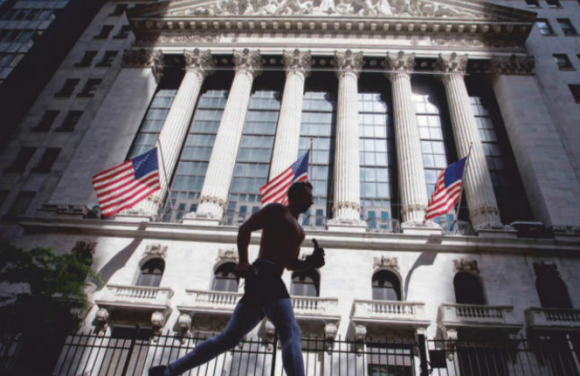The first act of the impact of the coronavirus on America's financial markets and banking system was characterised by panic.
冠状病毒对美国金融市场和银行体系影响的第一幕是恐慌。
As firms scrambled to amass the cash they needed to survive shutdowns,
各公司争先恐后地积累度过倒闭危机所需的现金,
they rushed to sell their holdings of securities and draw down their revolving credit lines.
他们匆忙抛售他们所持有的证券,并削减他们的周转信用额度。
Traders attempting to make markets from their sofas were overwhelmed with record volumes.
试图坐在沙发上做市场的交易员被交易量所淹没。
Banks' loan books and deposit accounts swelled. Risk managers frantically tried to compute potential loan losses.
银行贷款和储蓄存款增加。风险经理疯狂地试图计算潜在的贷款损失。
All this was reflected in the big banks' first-quarter earnings, reported in the middle of April.
所有这些都在大型银行四月中旬报告的第一季度收入中得到了反映。
Trading profits were sky high, lifting investment-banking revenues.
营业利润极高,这也抬高了投资银行的收入。
But bottom lines suffered as commercial banks set aside reserves to prepare for likely credit losses.
但随着商业银行为可能的信贷损失做拨款准备,盈亏底线受到了影响。
The second act was less turbulent, as government support quelled the panic.
第二幕没有那么混乱,因为政府的支持平息了恐慌。
Legislation passed in March bolstered unemployment benefits,
三月通过的立法巩固了失业津贴,
set up a lending scheme for small businesses and provided a backstop for the Federal Reserve to buy up corporate debt.
为小企业设立贷款计划,并为美联储购买公司债券提供了支撑。
This seems to have insulated firms and households from much of the damage, and has restored order to financial markets.
这似乎使公司和家庭免受了大部分损失,还重新恢复了金融市场的秩序。
But unease about the future remains. These dynamics were evident in the second-quarter earnings put out by Citigroup,
但对未来的不安依然存在。7月14日和15日,美国四大银行:花旗银行、

Goldman Sachs, JPMorgan Chase and Wells Fargo, four of America's largest banks, on July 14th and 15th.
高盛集团、摩根大通以及富国银行公布了第二季度收入,这些动态在其中非常明显。
(Bank of America and Morgan Stanley, America's other big lenders, were due to report on July 16th, as The Economist went to press.)
(美国银行和摩根士丹利,美国另外两大银行,将于本刊付印之际,即7月16日发布报告。)
As bond markets began to function again, firms rushed to sell securities.
随着债券市场重新开始运转,企业纷纷抛售证券。
In America companies have issued more than $2trn in equity and debt,
在美国,各公司已经发行了超过2万亿美元的股票和债券,
equivalent to 5% of the entire value of outstanding corporate bonds and public equity, and an increase of almost 50% on the year.
相当于未清偿企业债券和公共股权全部价值的5%,较上年同期增长近50%。
Accordingly, primary-issuance revenues at the four big banks rose by 56%, year over year, to $7.8bn.
因此,四大银行原始发行收入同比增长56%,达到78亿美元。
Traders stayed busy: trading revenues rose by 70% on the year to an all-time high of $26.9bn.
交易员依旧忙碌:交易收入比去年增长了70%,达到269亿美元的历史新高。
That reflected stronger client activity, as well as wider trading spreads, said Stephen Scherr, the chief financial officer of Goldman Sachs.
这反映出客户活动增强以及交易价差扩大,高盛集团的首席财务官Stephen Scherr说到。
More company bosses are now telling investors that they hold enough cash to cover two or three years' worth of outgoings.
现在,越来越多的公司老板告诉投资者,他们持有的现金足够覆盖两三年的支出。
Newly recapitalised companies are paying back revolving loans. Of the $55bn drawn down from JPMorgan in March $39bn has since been repaid.
新的资本重组公司正在偿还周转性贷款。在摩根大通今年三月削减的550亿美元资金中,已有390亿美元已偿还。
Commercial banks are bracing for the impact of the crisis, but it has yet to come.
商业银行正在为危机的影响做准备,但危机尚未到来。
Although 17.8m Americans were unemployed at the end of June, few have defaulted so far,
尽管6月底,有1780万美国人失业,但到目前为止几乎没有人违约,
thanks to stimulus cheques and meaty unemployment benefits, and banks' willingness to defer mortgage and credit-card payments.
这多亏了刺激计划支票和大量的失业救济,以及银行推迟抵押贷款和信用卡支付的意愿。
The four banks' charge-offs—ie, their write-offs for loans in default—
这四家银行的贷款冲销——即对违约贷款的勾销——
rose by just 22% to $4.9bn in the second quarter, up from $3.9bn during the same period in 2019.
从2019年同期的39亿美元上升到49亿美元,仅上升了22%。
By contrast, $29.5bn was set aside for provisions for expected losses, compared with just $3.9bn in the same quarter in 2019.
相比之下,银行为预期亏损拨备了295亿美元,而2019年同期仅为39亿美元。
译文由可可原创,仅供学习交流使用,未经许可请勿转载。













